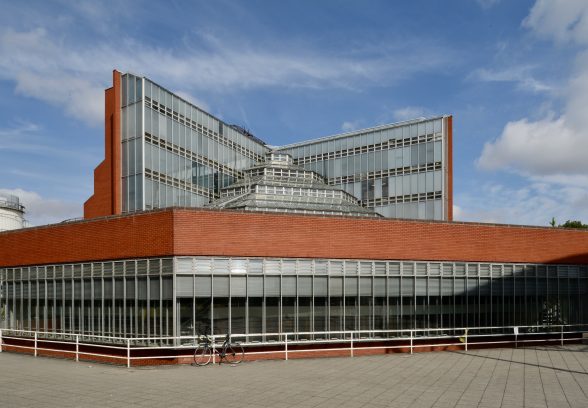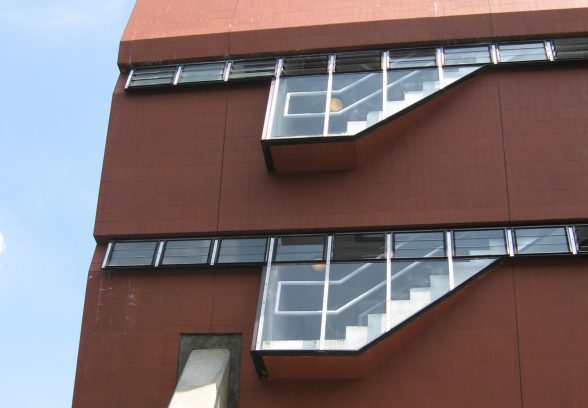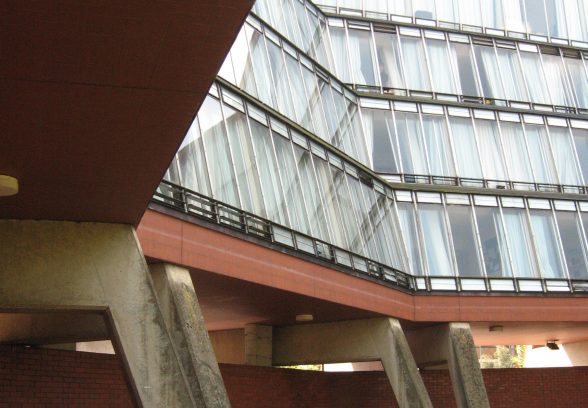This website uses cookies
This website uses cookies to enable it to function properly and to analyse how the website is used. Please click 'Close' to accept and continue using the website.





The Twentieth Century Society celebrates the Grade II* listing of two seminal James Stirling university buildings.
The Twentieth Century Society has succeeded in gaining greater recognition for the significance of James Stirling’s Florey Building at Queen’s College at Oxford and Cambridge University’s History Faculty after Historic England this week approved its applications to upgrade their listing status from Grade II to Grade II*.
“We are delighted by this decision,” said Clare Price, C20’s Head of Casework. “Not only does this celebrate the importance of these seminal buildings, which were pivotal in the development of the earlier part of Stirling’s oeuvre, but it also more robustly safeguards their future.” Grade II* buildings are “particularly important buildings of more than special interest” and make up only 5.8% of listed buildings in the country (2.1 % are Grade I and the vast majority, 91.7%, are Grade II).
Proposals to significantly extend Queen’s College Florey Building halls of residence so that all first year students can be housed there are currently on hold. Hopefully the revised listing will now encourage the College to change its strategy and develop a brief which will be more compatible with preservation of the original design.
The Florey Building (1966-1971) and the History Faculty (1964-68) along with the Engineering Building, University of Leicester, (with James Gowan 1960-63) which is already Grade II* listed, are part of a triumvirate of university buildings that are without doubt Stirling’s most significant works in England and the ones which established his reputation. They exemplify the most advanced state of development of the new architecture, pioneered by Stirling that broke away from the influence of Le Corbusier and the previously predominating and doctrinaire modernism of the mid-20th Century.
The Florey Building presents a modern reworking of the traditional Oxford quadrangle, with a cloistered ground-floor walk supporting the structure above, but open towards the river. The twin towers marking the entrance were described by Stirling, in a written note, as an analogue of a medieval gate tower. During the 1960s the generality of new university accommodation was still uniform ‘shoe boxes’, with only one aspect. At Oxford, Stirling made a bold attempt to deviate from this norm by providing split section rooms with dual aspects. The bedrooms of the Florey wrap round an open-sided courtyard, with an inward face of raked glazing.
The design of the Cambridge University’s History Faculty Library was the subject of a limited competition in 1963. Although the practice of Stirling and Gowan submitted the winning entry, the partnership was later dissolved and the university’s appointment was transferred to James Stirling’s new practice.
The building consists of a red brick clad, reinforced concrete, L-shaped block containing staff rooms, offices, seminar rooms and common rooms. The two wings of the building are connected by the glazed pyramid of a reading room for 300 students. The internal spaces of the library and surrounding corridors are among his most impressive interiors, of a surprising scale and quality not found in Stirling’s other English work.
Like other innovatory and highly original projects throughout the ages, both buildings proved controversial and attracted some vehement early criticism with demolition even being considered. With the passing of time and the perspective it provides, a more balanced and perceptive view has prevailed which, whilst acknowledging specific problems, recognizes the truly outstanding architectural importance of the buildings and the sheer brilliance of the design.
James Stirling was among the first post-war British architects to achieve widespread international standing. He received the Aalto Award in 1977, the RIBA Gold Medal in 1980, and in 1981 was the first British recipient of the Pritzker Prize, considered the world’s leading award to an architect. He was awarded the Japanese culture prize ‘Praemium Imperiale’ in 1990, and his knighthood was announced in 1992, shortly before his death. The Stirling Prize, the UK’s most prestigious architecture prize, was founded in 1996 in his memory.
Subject of a biography by Mark Girouard in 1998, the last few years have seen a revival of interest in his work, marked by the publication of a number of studies by authors including Geoffrey H Baker, Mark Crinson, Amanda Reeser Lawrence and Anthony Vidler. The latest issue of the C20 magazine will also be carrying a special feature on him.
For press enquiries:
Clare Price, Head of Casework, Twentieth Century Society
clare@c20society.org.uk 020 7250 3857

Become a C20 member today and help save our modern design heritage.